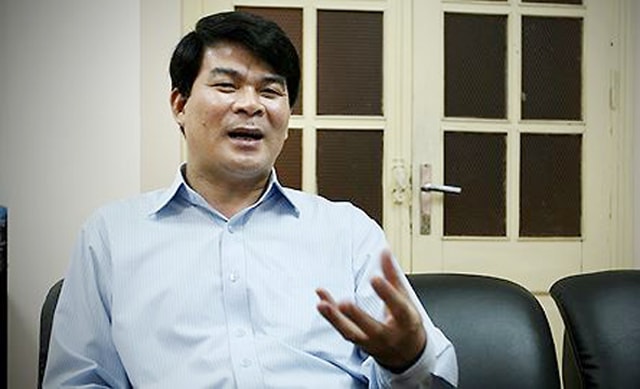Reasons why the machine "the more it reduces, the more it swells"
The recent streamlining of the apparatus mainly relied on the self-awareness of cadres, civil servants and public employees, while the responsibility rests with the leader.
In accordance with the spirit of Resolution No. 39 of the Politburo on streamlining the payroll and restructuring the staff, civil servants and public employees, by 2021, ministries, branches, political and social organizations, provinces and cities must reduce at least 10% of their payroll. On average, from 2015 to 2021 is 7 years, each year must reduce at least 2% of the payroll.
However, according to the Government's report, in 2017, there were more than 57,000 people in the State sector that were overstaffed. The results of 2 years of streamlining were an increase of 96,000 people. As 2021 is approaching, public opinion is wondering whether the target of reducing 10% by 2021 can be achieved successfully?
 |
| Former Deputy Minister of Home Affairs Nguyen Tien Dinh. |
Responsibility of the leader in streamlining the payroll
Sharing this concern, Dr. Nguyen Tien Dinh - former Deputy Minister of Home Affairs affirmed that at the current pace, we will certainly not achieve the goal. Mr. Dinh analyzed that, first of all, it is due to the implementation process, the policies and resolutions have clear solutions but in practice there are still many limitations.
Currently, agencies and units mainly rely on the self-awareness of cadres, civil servants and public employees, while policies affirm that responsibility belongs to the head. Through the process of assessment and classification in task assignment, in cases where the job position requirements are not met or the capacity and health are limited and cannot meet the task requirements, the classification will be included in the plan for streamlining according to the roadmap and cannot rely on self-awareness.
Then the practice of evaluating and classifying cadres, civil servants, and public employees shows that it is completely contrary to the reality in many agencies and units. The recent evaluation results show that about 97% of cadres, civil servants, and public employees achieve, complete well, or complete excellently their tasks while public opinion says that 30% of civil servants and public employees "go to work with an umbrella in the morning and come home with an umbrella in the evening". This shows that the responsibility of the leader is still very limited.
Another reason, according to Mr. Dinh, is that the workload of State agencies is still quite large. The Resolution requires reviewing the functions and tasks of agencies, units and the entire State apparatus, so that the tasks that the State sector does not perform effectively can be transferred quickly, but in reality, this is still limited. The large workload also requires an even larger number of cadres, civil servants and public employees, especially the workload of civil servants in the education and health sectors.
Summarizing the above issues, Mr. Dinh said that this is the reason why the process of streamlining staff and restructuring the apparatus is still very difficult and limited.
So how can we evaluate staff in a realistic way, to streamline the right subjects and determine the responsibilities of the leader?
According to Dr. Nguyen Tien Dinh, Decree 56 of the Government clearly stipulates that in the process of classification assessment, whoever assigns the task is responsible for the assessment. Thus, the first responsibility must still be the leader, to assess and classify the subjects to streamline, attract talented people, young people to work, not to remove any subject from the State.
The recent “trickle down” results cannot be without the responsibility of the leaders. As long as there is avoidance, deference, and reliance on collective opinions, the assessment cannot be substantive.
The former Deputy Minister of Home Affairs emphasized that streamlining is to improve the quality of the staff, civil servants and public employees in the apparatus. On the one hand, it is necessary to reduce the number of people with limited capacity who cannot meet the job position and whose health is not guaranteed in order to attract young people with quality and meet the requirements. This does not mean reducing without recruiting, but recruiting according to the principle of "2 out, 1 in".
Another requirement for the head is to review the functions and tasks of his agency accordingly. According to the spirit of the resolution, state agencies only focus on institutional issues, strategies, plans, inspections, supervision and policy implementation, the rest can be transferred, socialized, and converted into business models, joint stock companies or autonomous. Only then will there be no pressure on the budget.
Encouraging staff to leave early is very difficult and inappropriate.
Commenting on a number of solutions in many agencies, ministries and localities, Mr. Nguyen Tien Dinh said that the solutions according to Decree 108 of the Government are suitable in current conditions.
The solution of Da Nang to spend a sum of money to encourage cadres, civil servants and public employees to retire early is very difficult and inappropriate because it basically depends on the cadres' self-awareness. If not carefully evaluated, the limited budget will be used to pay for those who have the capacity to retire early and go out to work while those who need to be streamlined, those with limited capacity, not suitable for the job position or do not meet the requirements of that job position will still sit there. That is a burden and the set goal cannot be achieved/.

